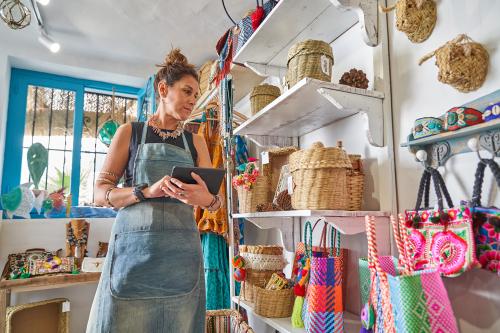Policymakers and academics are now catching up to financial institutions in their desire to understand how and why immigrants use U.S. financial markets. “Financial Access for Immigrants: Learning from Diverse Perspectives,” a conference co-sponsored by the Brookings Metropolitan Policy Program (formerly the Center on Urban and Metropolitan Policy) and the Federal Reserve Bank of Chicago, was held at the Chicago Fed on April 15-16, 2004. It included presentations from scholars and practitioners who discussed recent research on the financial practices of immigrants as well as the practical experiences of for-profit and nonprofit institutions working to provide financial services to the immigrant community.
Underscoring the broad interest in immigrant financial access, the conference audience was made up of financial institution representatives, academics, regulators, policymakers, and representatives of communitybased organizations and immigrant advocacy organizations. This Policy Brief highlights the research findings that were presented at the conference. To access the full conference presentations, visit the Chicago Fed’s homepage (www.chicagofed.org). Click on “Community Development” to get to the Center for the Study of Financial Access for Immigrants and the National Conference agenda.
FINANCIAL ACCESS FOR IMMIGRANTS
Foreign-born residents of the United States are much less likely than their native-born counterparts to use a wide range of financial services, including savings and checking accounts, business loans, and home mortgages. The degree to which immigrants have access to financial services has important implications for their current well-being as well as for the success of second generation immigrants. Because immigrants are often members of economically vulnerable groups, access to financial services may provide a means for immigrant households to cope with income uncertainty and to find pathways out of poverty. At the same time, immigrants’ access to financial services, particularly at mainstream institutions, may be hindered by factors such as low income, limited English language proficiency, residential segregation, cultural differences, or lack of experience with banks and other financial institutions.
The U.S. immigrant population grew by an unprecedented 57 percent between 1990 and 2000. One in nine current U.S. residents was born abroad. The 1990s also brought changes in immigrant settlement patterns, with movements away from traditional destinations toward areas that experienced litle immigration over the last century. Although the majority of immigrants currently live in just six states, the growth in the immigrant population in the 1990s was highest in new settlement areas in the Southeastern, Midwestern, and Rocky Mountain regions. These new destinations include major metropolitan areas as well as smaller cities and rural areas.
In the conference’s opening session, Roberto Suro of the Pew Hispanic Center described financial market participation as one aspect of the “long and complicated process of change that takes place when a society is transformed by immigration.” He said that American society is in a state of flux and that the process of assimilation involves changes not just among the newcomers but among the hosts as well. Financial markets are representative of this larger process: the nation’s financial institutions are in the process of adapting to meet the needs of incoming immigrants, and immigrants are in the process of learning the ropes.
There are several reasons to pay close attention to immigrant financial market participation. Financial institutions see immigrants as a large, growing, and relatively untapped market. Hispanics accounted for $653 billion in purchasing power in 2003, and Asians accounted for another $344 billion.
In 2002 alone, immigrants living in the United States sent $25 billion to relatives living in Latin America and the Caribbean. Total remittances to this region grew by 19 percent between 2002 and 2003. Financial institutions both large and small have made attracting immigrants a major focus of their business strategy, spending millions of dollars in advertising and developing products and services tailored to immigrants. As a result, the financial sector is well ahead of the research and policy community in recognizing the potential and the importance of incorporating immigrants into the financial mainstream.
For regulatory agencies, like the Federal Reserve Banks, ensuring fair and equal access to financial products and services is central to their missions. Regulations that formalize this mission, like the Community Reinvestment Act, the Equal Credit Opportunity Act, and the Fair Housing Act make it clear that financial institutions have a responsibility to ensure that their products and services are accessible to all sectors of society, including immigrants.
Community development organizations also have a stake in immigrant financial market participation because greater participation in housing and credit markets can help promote neighborhood stabilization and revitalization. A number of community-based organizations work in immigrant neighborhoods in an effort to fulfill their goals of promoting local economic development, assisting small businesses, and encouraging homeownership.
For researchers, immigrant financial market participation is relatively uncharted ground. While there is a plethora of research examining immigrant labor market and homeownership experiences, and a growing body of literature on the remittance market, there is little academic research on the topic of immigrant financial market incorporation.
CHANGING IMMIGRANT DESTINATIONS
In a presentation based on her paper, “The Rise of New Immigrant Gateways,” Audrey Singer of the Brookings Institution described immigration settlement patterns in historical and comparative perspective. This research shows how the enormous inflows of immigrants in recent decades are beginning to rearrange America’s immigration map, transforming new communities of settlement as well as established destinations.
Metropolitan areas across the United States have been decentralizing, and their suburban areas have grown during the latter part of the twentieth century. At the same time, there has been sustained immigration by a diverse set of immigrants. These trends have produced new immigrant settlement patterns that are affecting everyday life in many areas across the country.
Singer noted that more recent immigrants are going to emerging immigrant gateways such as Atlanta, Washington, D.C., Las Vegas, and Dallas-Ft. Worth. Thus, an increasing number of metropolitan areas across the United States with relatively small public, private, or informal infrastructure to help incorporate immigrants are facing the challenges associated with a substantial flow of newcomers.
Singer discussed the implications of these new patterns for immigrant incorporation, including the process of linking immigrants to mainstream financial markets. Identifying, developing, and maintaining community partnerships and collaborations enhances an area’s ability to extend services to immigrants. As an illustration, she described how several police departments around the country have initiated programs with local banks to encourage immigrants to open bank accounts. These partnerships help low-income immigrants put their money in banks, which reduces immigrants’ vulnerability to criminals who prey on them.
Although public safety and reducing crime is the impetus for these programs, they also serve to bring immigrants into formal relationships with the banking system and may facilitate longer-term financial integration. These programs also tend to improve relationships between police and immigrants where distrust and language barriers often exist.
IMMIGRANT FINANCIAL MARKET PARTICIPATION
Immigrants are less likely than their native counterparts to use a wide variety of financial services. They may be deterred by lower household incomes, language and cultural differences, and inexperience with domestic financial institutions.
Anna Paulson of the Federal Reserve Bank of Chicago presented research she conducted with Una Okonkwo Osili of Indiana University-Purdue University at Indianapolis. Their research focuses on how the quality of country-of-origin institutions shape financial choices that immigrants make once in the United States.
Paulson presented data from the Census Bureau’s Survey on Income and Program Participation (SIPP) from 1996 to 2000 (see figure 1). These data show that immigrants are less likely than native-born Americans to have bank accounts, stock, or to own homes.
In their analysis, institutional quality measures the ability of a country’s institutions to protect private property and provide incentives for investment. On a scale of one to ten, countries such as Switzerland and Luxembourg score perfect tens, and the United States is close behind at 9.98. Countries from which many immigrants to the United States originate score above the median of 7.07: Mexico, 7.51; China, 7.79; and Canada, 9.79.
Paulson and Osili look at two aspects of financial market participation: having a savings account and owning stock. To illustrate the impact of home country institutional quality, they demonstrate that immigrants from El Salvador, which has an institutional quality measure of 5.00, would have stock market participation that was 5.25 percentage points higher if El Salvador had been able to achieve Mexico’s institutional quality rating, all else remaining equal. The same increase in institutional quality would raise the likelihood that immigrants have a savings account by 4.75 percentage points.
Paulson and Osili find that the impact of home country institutional quality on immigrant behavior in the United States varies with age at migration. Immigrants who arrive in the United States between the ages of 16 and 21 exhibit behaviors similar to adult immigrants. Since these arrivals would have been unlikely to have had direct experience with financial or other institutions in their countries of origin, Paulson and Osili speculate that their orientation toward home country institutions stems from lessons absorbed at home or in schools in their country of origin.
Immigrants who arrive in the United States before they are sixteen years old exhibit financial market behavior closer to that of the U.S.-born population. Paulson and Osili also show that home country institutional orientation has a persistent influence on immigrant financial decisions–only immigrants who have lived in the United States for thirty-two years or more are unaffected by their home country institutions.
Sherrie Rhine of the Federal Reserve Bank of New York presented research that she conducted with William Green of New York University. They show how the use of checking and/or savings accounts by immigrants compares with that of the native-born, also using data from the SIPP. Their analysis focused on four immigrant groups: Mexicans, other Latin Americans, Europeans, and Asians. Their research shows that the factors that influence whether immigrants have bank accounts varies among these immigrant groups.
Overall, Rhine and Greene find that the most important characteristics influencing the likelihood of having a savings or checking account across most immigrant groups are education, net worth, and household income. The exception was for Mexican immigrants, whose most influential characteristics were poverty, work effort, citizenship status, and year of migration. Among Mexican immigrants, longer U.S. residence and being a U.S. citizen tend to improve the likelihood of having a savings or checking account.
MORTGAGES AND HOMEOWNERSHIP
There are wide disparities in homeownership rates between the native-born and immigrants. Past studies have suggested that a portion of the gap in homeownership rates can be explained by differences in socioeconomic, demographic, or geographic characteristics. More recently, studies have looked to alternative barriers such as citizenship status and language skills to explain differences in homeownership. Sherrie Kossoudji of the University of Michigan and Andrew Schoenholtz of Georgetown University each presented research on the homeownership status of immigrants compared to U.S.-born residents.
Kossoudji reported on joint work with Stan Sedo, also of the University of Michigan. Their analysis focuses on the relationship between immigrant citizenship status and homeownership.
Kossoudji and Sedo find that:
- Naturalized citizens and native-born residents living in urban areas are equally likely to be homeowners;
- Naturalized citizens and native-born homeowners are almost equally likely to have no mortgage, and have similar debt-to-value ratios when they do have a mortgage;
- Noncitizen immigrants lag behind on every measure, no matter how many years they have lived in the United States;
- Homeownership comprises a higher proportion of wealth for both naturalized citizens and non-citizens than it does for native-born U.S. residents.
Schoenholtz identified major barriers to immigrant homeownership and presented best practices to overcome these barriers, which were derived from his study, “Reaching the Immigrant Market and Creating Homeownership Opportunities for New Americans.” The study found the greatest barriers to immigrant homeownership included unfamiliarity with the U.S. credit system, lack of credit history, language limitations, and a limited supply of affordable housing.
In order to help guide institutions to overcome these barriers, Schoenholtz has produced a handbook for financial institutions that describes model programs for reaching immigrants who want to buy homes.
First, financial institutions should identify potential immigrant homeowners and then network with faith-based, ethnic, or neighborhood groups to build bridges to those markets. Through these partnerships, financial institutions can develop relationships with individuals who are engaged in the community, culturally aware, and bilingual. Financial institutions should also provide training on the technical aspects of the mortgage lending industry. Finally, the study recommends that loan products be affordable and better cater to the needs of immigrants.
BUSINESS LENDING AND ENTREPRENEURSHIP
Previous research has shown that immigrants are more likely to be self-employed than native-born Americans. Self-employment continues to be an important means by which immigrants improve their socioeconomic standing. Raising start-up funds is a significant challenge for immigrant entrepreneurs. However, immigrants make little use of bank loans in financing new business ventures. While U.S.-born entrepreneurs are also unlikely to get start-up capital from banks, the reasons that native and immigrant entrepreneurs do not use bank loans are likely to differ.
The Federal Reserve Bank of Chicago’s Maude Toussaint-Comeau described patterns of entrepreneurship among immigrant groups. She reported that personal assets are the main source of business financing for immigrants and highlighted other sources of start-up capital. The majority of immigrant entrepreneurs are ethnic minorities and often face language barriers that can hinder entrepreneurial behavior. Immigrants are more likely to start businesses in areas with high concentrations of other immigrants who speak their language and/or who come from the same country as they do. Toussaint-Comeau highlighted the importance of affordable housing in neighborhoods adjacent to concentrations of ethnic businesses.
Pyong Gap Min of Queens College and the Graduate Center of the City University of New York focused his presentation on sources of start-up capital for Asian entrepreneurs. He stressed that ethnic sources of start-up capital are not used as widely as is commonly thought. Summarizing results from studies of Korean, Taiwanese, and Japanese immigrants, he showed that Asian immigrants rely mainly on personal assets to start businesses. Recently, Asian immigrant newcomers have turned to homeland or ethnic banks for start-up capital because credit checks are simpler than in mainstream institutions, and there are typically no language barriers.
In her research on micro-lending in unincorporated cities along the U.S.-Mexico border, Barbara Robles discussed the unique economic situation of the Borderlands area and how microenterprise activities supported by community-based organizations there encourage eventual transition to mainstream economic activities. Although the Borderlands are a distinct region of the United States, they exemplify the importance of establishing trust and longevity in ethnic enclaves in order to achieve sustainable community development in an area. Robles emphasized that models that work best are built inside communities rather than externally imposed.
INTERNATIONAL LINKAGES AND REMITTANCE FLOWS
Existing research focuses on potential motivations for sending remittances, which include altruism, financing emigration of family members, investment in the human capital of family back home—such as in education and medical care—insuring family against regional shocks, and investment in economic development projects in hometown communities. The large flow of dollars from the United States to Latin America and the Caribbean has focused recent research attention on examining patterns of remittances from the United States to this region.
B. Lindsay Lowell of Georgetown University discussed the factors that may contribute to a slowing of remittance flows from the United States to Latin America and the Caribbean. According to Lowell, an estimated $19.3 billion in remittances was sent from the United States to Mexico and Central America in 2003. His analysis examines the role of duration of stay in the United States and level of education in explaining remittance flows.
Lowell finds that remitting decreases as time spent in the United States increases. Since the proportion of immigrants who have been in the United States less than ten years is a decreasing share of all immigrants, Lowell speculates that growth in remittances will slow down relative to the growth rates observed between 1990 and 2000.
Lowell also finds that since more educated immigrants tend to migrate to the United States with their families, they have less need to send money back home. As a result, they tend to remit less and stop remitting sooner compared to less-skilled immigrants.
Manuel Orozco of Georgetown University presented his paper, “The Remittance Marketplace: Prices, Policy and Financial Institutions,” which focused on changes in the remittance market, especially the cost of sending remittances over the past ten to fifteen years. He noted that while transfer costs have been gradually declining, fees remain expensive, with transfer costs varying depending on the receiving country.
Another key finding of Orozco’s study is that banks have captured only a very small fraction of the remittance market (see figure 2). Although many banks and credit unions have initiated remittance services in recent years, money transfer firms remain the dominant players in this market. Orozco pointed out links between the provision of remittance services and other financial products, emphasizing the potential for banks that offer remittance services to reach out to people without savings and checking accounts. He argues that remittance services present a major opportunity for banks to establish long-term relationships with immigrant remittance senders.
The Brookings Institution is committed to quality, independence, and impact.
We are supported by a diverse array of funders. In line with our values and policies, each Brookings publication represents the sole views of its author(s).


